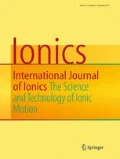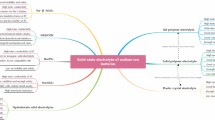Abstract
α-Fe2O3 and Fe3O4 hollow nanospheres of size 30 ± 2 nm were synthesized by using polymeric micelles as a soft template for the first time. The hollow nanospheres were thoroughly characterized by transmission electron microscope, superconducting quantum interference device, X-ray diffraction, Fourier transform infrared spectroscopy, thermogravimetry and differential thermal analysis, cyclic voltammogram, and nitrogen sorption analyses. The α-Fe2O3 and Fe3O4 hollow nanospheres were used as anode materials in lithium-ion rechargeable batteries to investigate their electrochemical properties. The hollow particle-based electrodes exhibit high capacity, stable cycling performance, and good rate capability at different current densities. The α-Fe2O3 and Fe3O4 hollow nanospheres with nanosized shell domain favors fast lithium insertion/extraction processes during the repeated charge/discharges.







Similar content being viewed by others
References
Armand M, Tarascon JM (2008) Nature 451:652
Li N, Martin CR, Scrosati B (2001) J Power Sources 97–98:240
Wang H, Abe T, Maruyama S, Iriyama Y, Ogumi Z, Yoshikawa K (2005) Adv Mater 17:2857
Park M, Kang Y, Wang G, Dou S, Liu H (2008) Adv Funct Mater 18:455
Chen J, Cheng F (2009) Acc Chem Res 42:713
Jiang C, Hosono E, Zhou H (2006) NanoToday 1:28
Poizot P, Laruelle S, Grugeon S, Dupont L, Tarascon JM (2000) Nature 407:496
Xu XN, Wolfus Y, Shaulov A, Yeshurun Y, Felner I, Nowik I, Koltypin Y, Gedanken A (2002) Appl Phys Lett 91:4611
Ji J, Ohkoshi S, Hashimoto K (2004) Adv Mater 16:48
Woo K, Lee HJ, Ahn JP, Park YS (2003) Adv Mater 20:1761
Wang X, Chen X, Gao L, Zheng Z, Ji M, Tang C, Sen T, Zhang Z (2004) J Mater Chem 14:905
Fu YY, Wang RM, Xu J, Chen J, Yan Y, Narlikar AV, Zhang H (2003) Chem Phys Lett 379:373
Shen XP, Liu HJ, Pan L, Chen KM, Hong JM, Xu Z (2004) Chem Lett 33:1128
Larcher D, Masquelier C, Bonnin D, Chabre Y, Masson V, Leriche JB, Tarascon JM (2003) J Electrochem Soc 150:A133
Larcher D, Bonnin D, Rivals I, Personnaz L, Tarascon JM (2003) J Electrochem Soc 150:A1643
Morales J, Sanchez L, Martin F, Berry F, Ren X (2005) J Electrochem Soc 152:A1748
Chen J, Xu L, Li W, Gou X (2005) Adv Mater 17:582
Khanal A, Inoue Y, Yada M, Nakashima K (2007) J Am Chem Soc 129:1534
Tan H, Xue JM, Shuter B, Li X, Wang J (2010) Adv Funct Mater 20:722
Bang JH, Suslick KS (2007) J Am Chem Soc 129:2242
Peng S, Sun S (2007) Angew Chem Int Ed 46:4155
Yi DK, Selvan ST, Lee SS, Papaefthymiou GC, Kundaliya D, Ying JY (2005) J Am Chem Soc 127:4990
Xing WB, Dahn JR (1997) J Electrochem Soc 144:1195
Mukai SR, Hasegawa T, Takagi M, Tamon H (2004) Carbon 42:837
Zhang WM, Wu XL, Hu JS, Guo YG, Wan LJ (2008) Adv Funct Mater 18:3941
Tartaj P, Amarilla JM (2011) J Power Sources 196:2164
Guo YG, Hu YS, Sigle W, Maier J (2007) Adv Mater 19:2087
Aifantis KE, Huang T, Hackney SA, Sarakonsri T, Yu A (2012) J Power Sources 197:246
Taberna PL, Mitra S, Poizot P, Simon P, Tarascon JM (2006) Nat Mater 5:567
Ban C, Wu Z, Gillaspie DT, Chen L, Yan Y, Blacburn JL, Dillion AC (2010) Adv Mater 22:E145
Acknowledgments
One of the authors (KN) thanks the Japan Society for the Promotion of Science for a Grant-in-Aid for Scientific Research (20310054).
Author information
Authors and Affiliations
Corresponding author
Electronic supplementary material
DLS, TG/DTA, FTIR and SQUID data.
Below is the link to the electronic supplementary material.
ESM 1
(DOC 166 kb)
Rights and permissions
About this article
Cite this article
Sasidharan, M., Gunawardhana, N., Yoshio, M. et al. α-Fe2O3 and Fe3O4 hollow nanospheres as high-capacity anode materials for rechargeable Li-ion batteries. Ionics 19, 25–31 (2013). https://doi.org/10.1007/s11581-012-0716-x
Received:
Revised:
Accepted:
Published:
Issue Date:
DOI: https://doi.org/10.1007/s11581-012-0716-x




